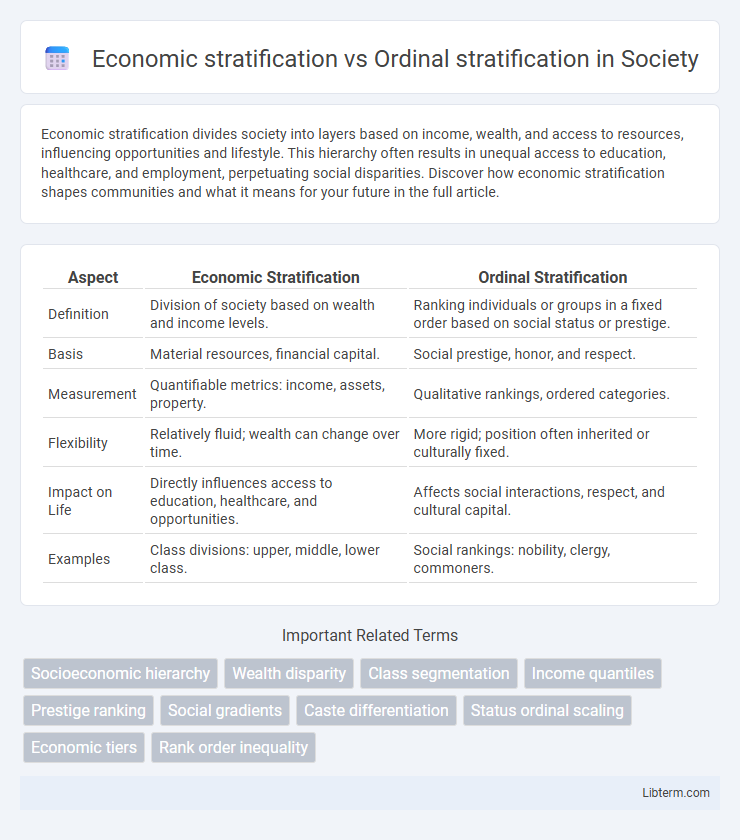Economic stratification divides society into layers based on income, wealth, and access to resources, influencing opportunities and lifestyle. This hierarchy often results in unequal access to education, healthcare, and employment, perpetuating social disparities. Discover how economic stratification shapes communities and what it means for your future in the full article.
Table of Comparison
| Aspect | Economic Stratification | Ordinal Stratification |
|---|---|---|
| Definition | Division of society based on wealth and income levels. | Ranking individuals or groups in a fixed order based on social status or prestige. |
| Basis | Material resources, financial capital. | Social prestige, honor, and respect. |
| Measurement | Quantifiable metrics: income, assets, property. | Qualitative rankings, ordered categories. |
| Flexibility | Relatively fluid; wealth can change over time. | More rigid; position often inherited or culturally fixed. |
| Impact on Life | Directly influences access to education, healthcare, and opportunities. | Affects social interactions, respect, and cultural capital. |
| Examples | Class divisions: upper, middle, lower class. | Social rankings: nobility, clergy, commoners. |
Introduction to Stratification in Economics
Economic stratification organizes society based on income, wealth, and access to resources, creating distinct economic classes that influence individuals' financial stability and opportunities. Ordinal stratification ranks individuals or groups on a hierarchy according to social status or prestige without precise economic measurements, emphasizing relative social positions. Understanding both types clarifies how economic disparities and social rankings shape inequality and mobility within economies.
Defining Economic Stratification
Economic stratification refers to the categorization of individuals or groups based on their income, wealth, and financial resources, creating distinct economic classes such as upper, middle, and lower strata. This form of stratification emphasizes material assets and economic power as key determinants of social status and access to opportunities. Unlike ordinal stratification, which ranks individuals on a single hierarchical scale, economic stratification specifically highlights the disparities in economic capital and living standards among social groups.
Understanding Ordinal Stratification
Ordinal stratification classifies individuals or groups based on a ranked order of social status or economic position without specifying exact differences between ranks. Unlike economic stratification, which categorizes based on quantifiable wealth or income levels, ordinal stratification emphasizes hierarchical placement in social structures, such as class or prestige rankings. This approach helps sociologists understand relative social standing and mobility by focusing on rank order rather than precise economic measures.
Key Differences Between Economic and Ordinal Stratification
Economic stratification classifies individuals based on quantifiable wealth, income, and material resources, creating distinct economic classes such as lower, middle, and upper class. Ordinal stratification arranges people in a ranked order or hierarchy without precise measurement, emphasizing relative social status, prestige, or honor. Key differences include economic stratification's focus on measurable financial assets versus ordinal stratification's emphasis on social ranking and subjective status within a social hierarchy.
Historical Evolution of Stratification Concepts
Economic stratification historically centers on wealth distribution and class divisions shaped by industrialization and capitalist economies, emphasizing tangible assets and income disparities. Ordinal stratification, emerging from sociological studies in the 20th century, maps social hierarchies based on status, prestige, and rank rather than solely economic indicators. This evolution reflects a shift from purely materialistic interpretations of stratification to multifaceted analyses incorporating social honor and power gradients.
Measurement Metrics in Economic vs Ordinal Stratification
Economic stratification is measured primarily through quantitative metrics such as income level, wealth accumulation, and occupational status, reflecting individuals' material resources and economic power. Ordinal stratification, however, employs a ranking system that categorizes social positions in a hierarchical order without precise numerical distance, often using scales like social class rankings or status groupings. Measurement metrics in economic stratification emphasize continuous variables and exact data, whereas ordinal stratification relies on relative, non-numeric positioning to capture social disparities.
The Impact of Stratification on Social Mobility
Economic stratification, based on income and wealth disparities, significantly restricts social mobility by limiting access to quality education, healthcare, and professional opportunities. Ordinal stratification ranks individuals within a social hierarchy, influencing social mobility through perceived social status and cultural capital, which can either facilitate or hinder upward movement. Both forms of stratification create systemic barriers that reinforce existing social positions and reduce the likelihood of achieving intergenerational economic advancement.
Case Studies: Real-World Applications
Economic stratification often appears in case studies analyzing income distribution, such as the Gini coefficient application in Brazil, highlighting wealth disparities and social mobility constraints. Ordinal stratification is frequently explored through educational attainment rankings in Scandinavian countries, demonstrating how social status aligns with hierarchical class positioning despite economic equality. Comparative research in India illustrates the intersection of both stratification types, revealing complex layers of caste-based ordinal status intersecting with economic inequalities.
Policy Implications of Stratification Types
Economic stratification primarily influences policies targeting income redistribution, social welfare, and taxation to address wealth inequality and poverty reduction. Ordinal stratification emphasizes social mobility and status hierarchies, guiding policies that focus on education access, employment opportunities, and equal rights enforcement. Understanding these stratification types enables tailored policy frameworks that balance economic equity with social inclusion and mobility enhancement.
Future Trends in Stratification Analysis
Economic stratification primarily examines disparities based on income, wealth, and material resources, while ordinal stratification ranks individuals or groups by social status, prestige, or class hierarchy. Future trends in stratification analysis emphasize integrating big data and machine learning to map complex interactions between economic variables and social positions, enabling more nuanced models of inequality. Researchers increasingly explore dynamic, multidimensional frameworks that capture both economic outcomes and social mobility trajectories over time.
Economic stratification Infographic

 libterm.com
libterm.com